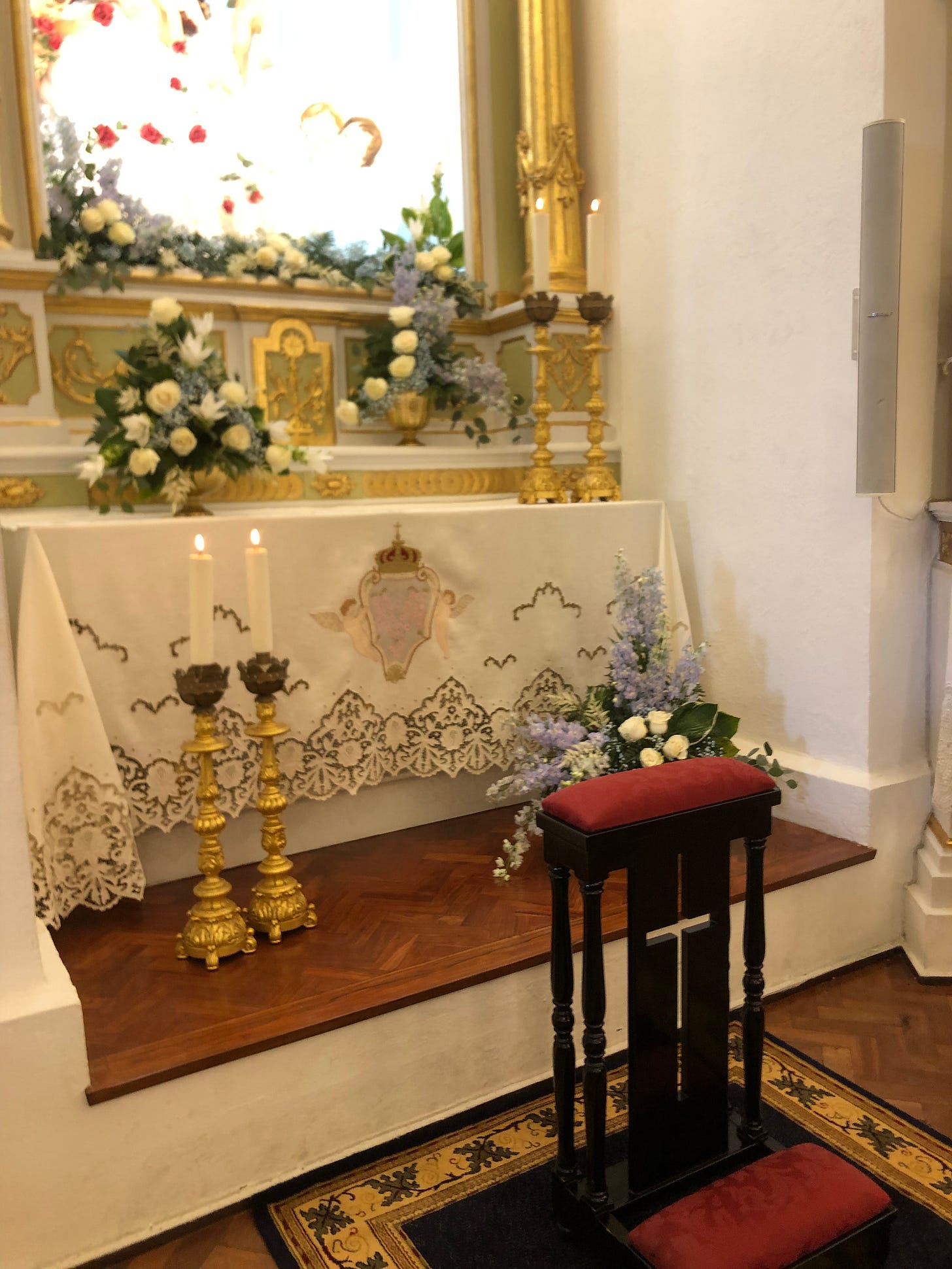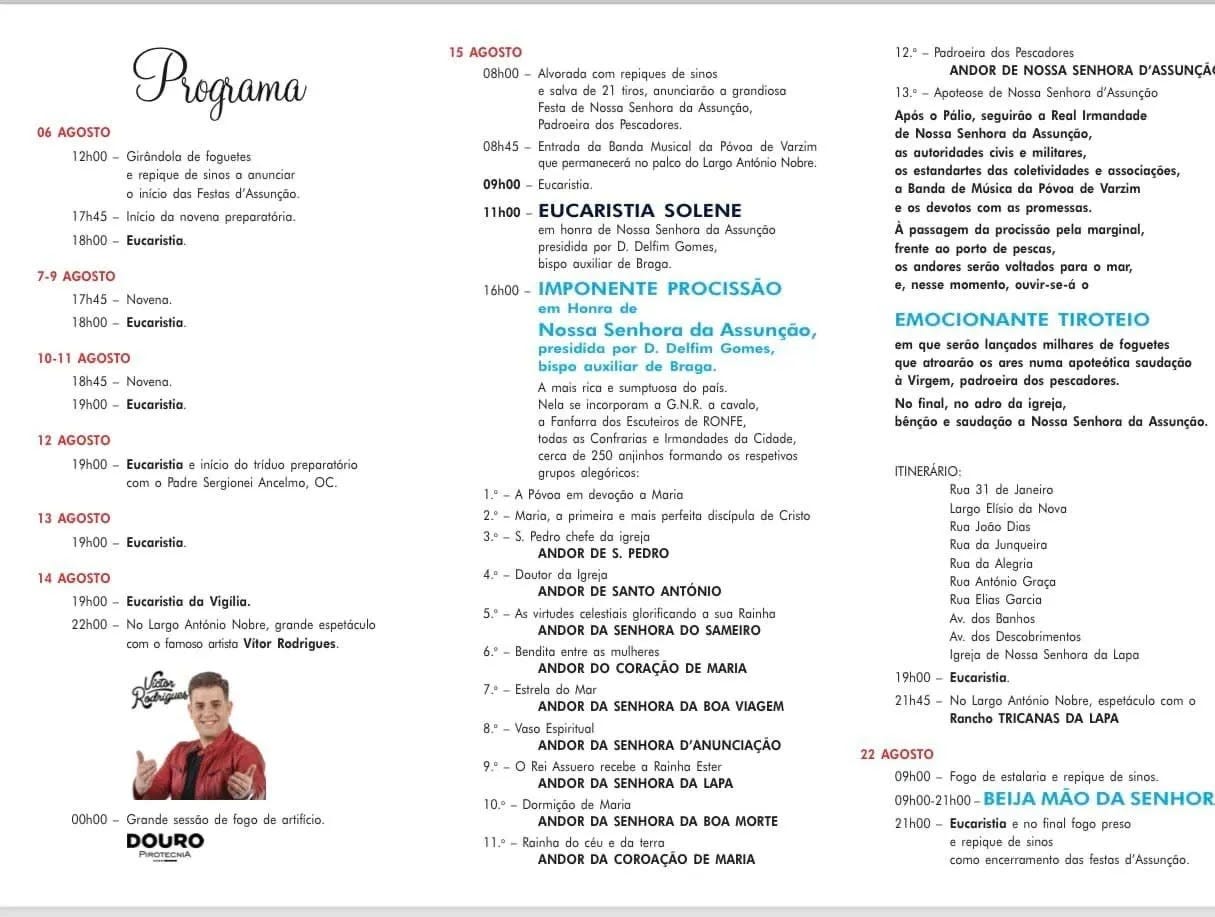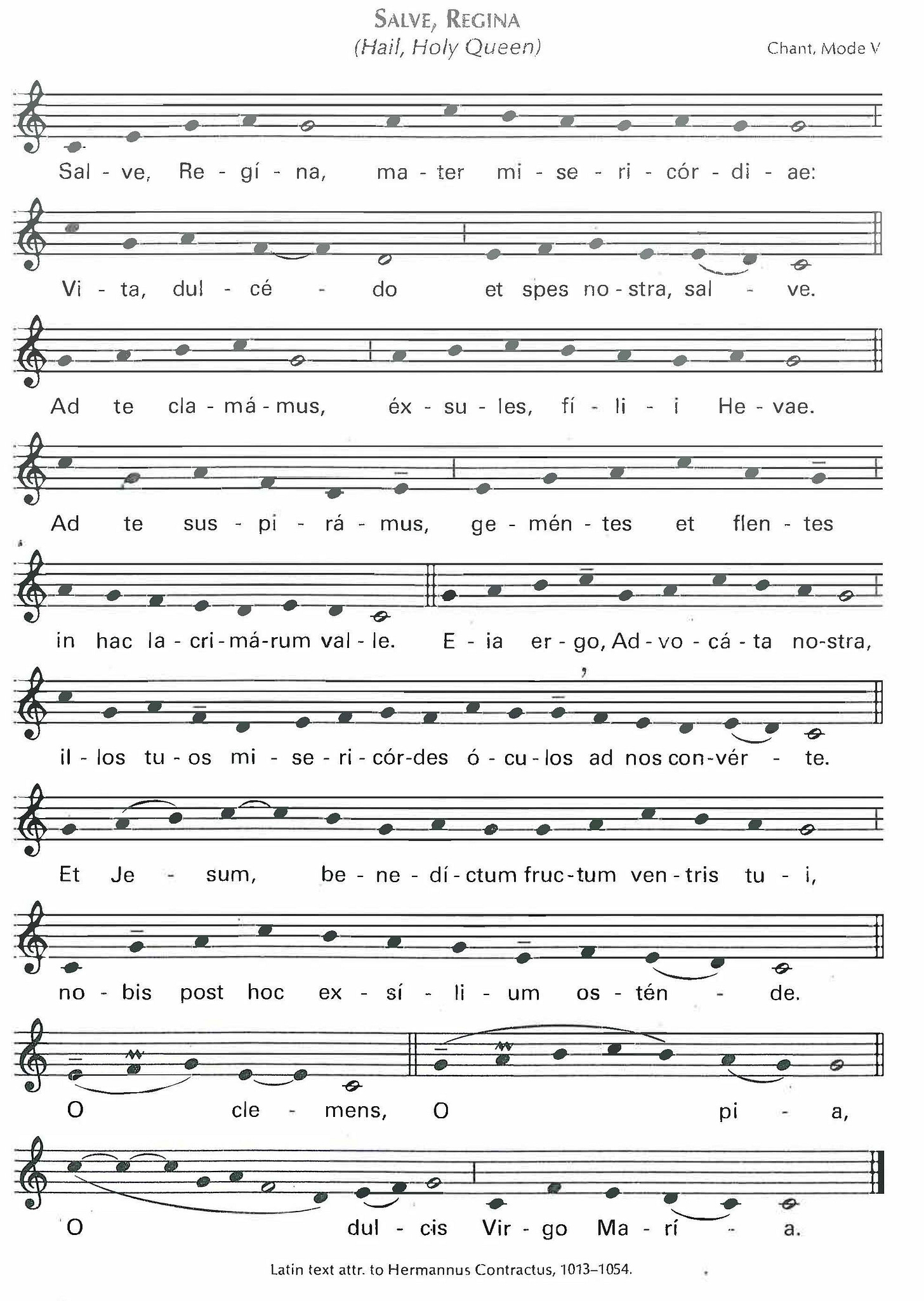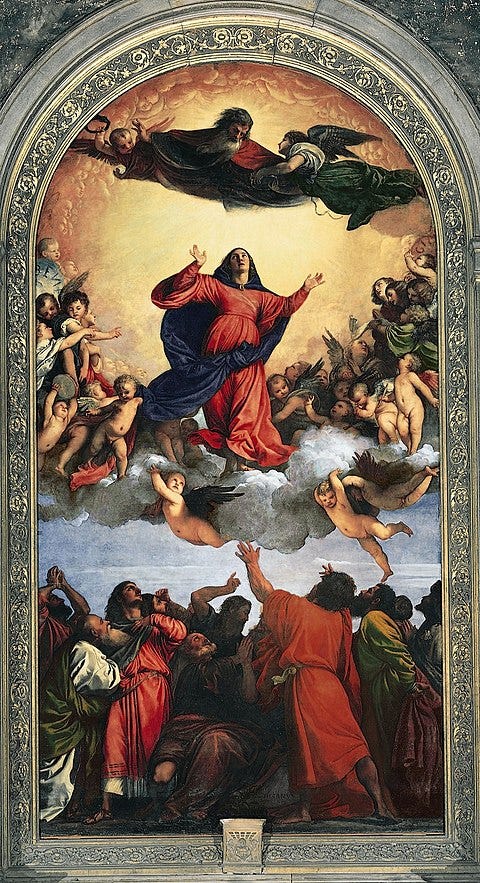ROSARY ON THE CAMINO NEWSLETTER | AUGUST 15th on the CAMINO
Dear Friends:
The following programme highlights explore the various festivities leading up to the August 15th National Holiday, celebrated in Póvoa de Varzim, a city named by the local museum curator at a recent ENCONTRO as “Land of Our Lady and the Rosary”.
During his sermon on August 7, 2024, Fr. Nuno Rocha, current pastor at Lapa, noted that the statues at Igreja da Lapa are a gift to the community and all visiting: they provide a means for more deeply contemplating Our Lady in Heaven who represents “the eschatological icon of the Church” as taught in the catechism (CCC), and they help us to contemplate the mysteries of the Rosary.
Why is the Feast of Mary’s Assumption a Holy day of obligation? Why is it called a Solemnity? What do we need to know about the assumption? Learn more with this video:
TEACHING THE GLORIOUS MYSTERIESIn the above poster is an image of Our Lady of the Assumption, the focus of the Procession on August 15th - which teaches the 4th Glorious Mystery Terço prayed daily at LAPA. Here are the Glorious Mysteries to pray for this coming Sunday:
If you don’t know what the Rosary is, watch the following video to learn more from Fr. Peter Turrone (IMC) depicted in the above video:
The sculpture of "Our Lady of the Assumption” one of the four Marian dogmas.1 (1950) which you can read about in the footnotes from an online article cited for Educational Use Purposes only.

LAPA: ANNUAL SOLEMN NOVENA & MASS FROM AUGUST 6-14th
From the 6th (the Feast of the Transfiguration) to the 14th of August, the Church of Our Lady of Lapa begins the annual 9-day novena in honour of Our Lady of the Assumption before the image depicted in the poster above and which was sculpted by the great Portuguese artist João d’ Affonseca Lapa.
Igreja de Nossa Senhora da Lapa, Póvoa de Varzim houses sacred art in the form of grand sculptures which are “naturalistic and carved with great erudition and technical expertise” according to local expert, Dra. Deolinda Carneiro, PhD.
PROGRAMME HIGHLIGHTS
6 a 11 de Agosto
Novena em honra de Nossa Senhora da Assunção Eucaristia
7, 8, 9 AGOSTO - 17h45 NOVENA + 18h00 EUCHARISTIA
Celebrant, Pe. Nuno
10, 11 AGOSTO - 18h45 NOVENA + 19h00 EUCHARISTIA
DIAS 12, 13, 14 às 19h00 - TRÍDUO da FESTA, com pregação de Pe Sergionei Ancelmo, Ordem do Carmo; Novena preparatória em Honra de Nossa Senhora da Assunção -- 15 minutos antes da eucaristia da tardeDia 14, Terço às 18h10
19h00 — Missa da Vigília da Sra. Da Assunção
Dia 15,
15 de Agosto
09:00 - Entrada da Banda Musical da Póvoa de Varzim no largo da Igreja Nª Sr.ª da Lapa, que percorrerá várias ruas da cidade.
09:00 - Entrada da Banda Musical da Póvoa de Varzim no largo da Igreja Nª Sr.ª da Lapa, que percorrerá várias ruas da cidade.
09h00 - Missa do Dia;
11h - Missa Solene — presidada por D. Delfim Gomes, bispo auxiliar da Diocese de Braga
16h00-19h00 Imponente Procissão em honra de Nossa Senhora d’Assunção
Missa da tarde (19h00 / 19h30 Eucaristia)
22:00 - GRANDE ESPETÁCULO ZÉ AMARO
00:00 - GRANDE SESSÃO DE FOGO DE ARTIFÍCIO
22 de Agosto
09:00 - 19:00 - ”BEIJA MÃO” da Senhora
21:00 - Eucaristia + Salve Regina (Learn the Melody below and listen to the video from Lapa); Fr. Anthony teaches briefly about the Queen of Heaven.
LAST YEAR’S AUG 22 MISSA D ENCERRAMENTO
Lapa has begun to decorate for the Festa since the Aug 6 Novena began! There is still time to join in prayer. Rosary starts on weekdays at 5:15 sharp, and 6:15 on Saturdays / Sundays with Novena led by Fr. Nuno followed by the Holy Sacrifice of the Mass.
Please arrive early as there are limited seats due to the preparations for the above events.
SOLEMN NOVENA TO FOLLOW c/o LAPA.
WONDERING WHERE TO PRAY IN PARIS, FRANCE from AUGUST 12-15?
https://www.sacre-coeur-montmartre.com/infos-et-visites/informations-pratiques/horaires-et-acces
RETRAITE DE L'ASSOMPTION - 2024
du LUNDI 12 août (AVANT 19h) au JEUdi 15 août (17h30) 2024.
Enseignements donnés par le père Stéphane ESCLEF, Recteur de la basilique, Chanoine de Notre-Dame de Paris et Missionnaire de la Miséricorde.
« Laissons-nous entraîner par Marie, la première en chemin »
PROGRAMME DE LA RETRAITE
LUNDI 12 AOÛT – Accueil jusqu’à 19h
19h30 Diner
21h Enseignement introductif à la retraite
21h30 Complies
NUIT D’ADORATION MERCI DE VOUS INSCRIRE
MARDI 13 AOÛT
8h Office des Lectures et Laudes
9h45 Enseignement 1
11h Messe
12h Office du milieu du jour
12h30 Déjeuner
15h00 Enseignement 2
16h30 Parcours à la Crypte : ‘La bible, une bonne nouvelle pour aujourd’hui’
18h Vêpres
19h30 Dîner
20h45 Prière du Chapelet dans la basilique
21h30 Complies
NUIT D’ADORATION MERCI DE VOUS INSCRIRE
MERCREDI 14 AOÛT
8h Office des Lectures et Laudes
9h45 Enseignement 3
11h Messe
12h Office du Milieu du jour
12h30 Déjeuner
15h00 Enseignement 4
16h15 FILM sur Fatima
18h 1ères vêpres de l’Assomption
19h30 Dîner
21h VEILLEE DE PRIERE MARIALE AVEC PROCESSION AUX FLAMBEAUX ( Départ de la Basilique)
22h30 Messe de la veille au soir de l’Assomption
JEUDI 15 AOÛT
Libérer les chambres avant 9h30 et remettre les clés.
Petit déjeuner entre 7h et 8h30.
8h Laudes et office des lectures
9h30 LECTIO DIVINA SUR LES LECTURES DE LA SOLENNITE DE L’ASSOMPTION (Par une sœur )
10h15 Temps libre pour la prière
11h Messe solennelle de l’Assomption
12h30 Déjeuner
14h30 Café fraternel
16h Vêpres solennelles de l’Assomption suivies d’une procession mariale dans les jardins de la Basilique
(Apporter des roses entières pour la procession)
FIN DE LA RETRAITELEARN MORE ABOUT THE ROLE OF MARY: ASSUMPTION, CORONATION, ETC.
The Narrator of the Rosary Hour Podcast, Fr. Chris Alar, MIC invites you learn more about Our Lady in the following video. (Scroll down to the footnotes for an abbreviated video).
NOTES
DOGMA 1: “Theotokos”, Mother of God
Early Marian devotion considered Mary the Theotokos (“God-bearer”), or Mother of God. As the Church came to understand Christ as fully human and fully divine, this view of Mary as Theotokos was challenged by those who said Mary gave birth to the human Jesus but not to His divinity. In the fifth century, Nestorius, archbishop of Constantinople, said Mary should be called Christotokos (“Christ-bearer”) but not Theotokos.
The debate led to the Council of Ephesus, which in 431 proclaimed that Mary was indeed the Mother of God. The council further explained that Christ’s divine and human nature were united in one person, not two separate persons as Nestorius asserted, and so it is correct to say that Mary gave birth to the person who was God.
This mystery is the foundation of all the other dogmas, said Fr. Barbour.
“This mystery establishes that the Eternal Son of God has one sonship since He is one person,” he said. “Even though He has two births, one eternally of the Father as God, and the other as man in time of His Mother, He is still one son, just as any son is the son of both his father and his mother, not having two sonships, one of his father and the other from his mother.”
Perpetual virginity
Mary’s virginal conception and birth of Jesus were never in question due to the clarity of Scripture, but even her perpetual virginity — that she remained a virgin her entire life — was held by many of the early Church Fathers as well. It also was generally accepted by the faithful. In 553, the Second Council of Constantinople gave Mary the title “ever-virgin”; in 649, Pope Martin I convened a council at which he declared dogmatically that “ever-virgin” meant that Mary indeed retained her virginity perpetually.
There is a very early tradition, expressed in the apocryphal Protoevangelium of James, that Mary had vowed a life of perpetual virginity as a young girl and was betrothed to Joseph so he could serve as her guardian and protector in a celibate marriage, as was the practice in such instances.
Although the Gospels refer in places to the “brethren” or “brothers” of Jesus, the term translated as “brothers” (adelphos in the Greek) could also refer to other male relatives such as cousins or uncles, to spiritual “brothers,” or even men from the same tribe. It is sometimes speculated that these “brothers” were actually stepbrothers, sons of Joseph from a previous marriage. Such views are compatible with Mary’s perpetual virginity.
Speaking at a conference in Capua in 1992, Pope St. John Paul II related Mary’s perpetual virginity to her virgin birth.
“She gave birth to Jesus, truly and in a virginal way; that is why she remained virgin after giving birth, according to the holy Fathers and the councils who have expressly treated the question. The same is true about her bodily integrity,” the pope said. “She lived, after Jesus’ birth, in total and perpetual virginity; and together with St. Joseph, who was himself called to play a predominant role in the events of our salvation, she dedicated herself to the service of the person and work of Jesus.”
Immaculate conception
Mary’s Immaculate Conception means that Mary was conceived by her parents but was miraculously kept free from original sin. This was a special grace to prepare her for becoming the Mother of God, since she was chosen by God Himself for this role. The belief was widely accepted by the time Pope Pius IX, In his 1854 apostolic constitution Ineffabilis Deus, proclaimed the dogma of Mary’s Immaculate Conception, teaching that from the moment of her conception, by a special “grace and privilege” from God, she “was kept free from every stain of original sin.”
It is sometimes confused with Mary’s miraculous conception of Jesus, which it is not.
The Catechism of the Catholic Church states that after they committed the first sin, “Adam and Eve immediately lose the grace of original holiness” (399). Original sin is passed on to Adam’s posterity, the Catechism continues. “By one man’s disobedience many [that is, all men] were made sinners,” writes St. Paul (Rom 5:12). While baptism takes away original sin, the Catechism states, human nature is still “weakened in its powers; subject to ignorance, suffering, and the domination of death; and inclined to sin (This inclination is called ‘concupiscence’)” (418).
“As the Mother of the Incarnate Son of God and Redeemer, then, Mary must be utterly free from all sin or state of sin, original or personal,” Father Barbour explained. “This means she is created in the fullness of grace, immaculately conceived in her holy parents’ natural union, untouched by the fall of our first ancestors, fit to be a Second Eve for the Second Adam, truly the ‘Mother of all the living’ by grace and charity.”
Assumption into heaven
The Assumption is the doctrine that says that Mary was assumed into heaven, body and soul, at the end of her life by an act of God. The Church does not suggest whether she died before she was assumed. Belief in the Assumption of Mary is recorded as early as the second or third century, so it is a longheld tradition. The Eastern Orthodox tradition refers to the “Dormition of the Theotokos,” which commemorates the painless, peaceful death of Mary and her subsequent “taking up” into heaven.
Pope Pius XII proclaimed the dogma of the Assumption in 1950 in his encyclical Munificentissimus Deus: “[W]e pronounce, declare, and define it to be a divinely revealed dogma: that the Immaculate Mother of God, the ever Virgin Mary, having completed the course of her earthly life, was assumed body and soul into heavenly glory.”
The Assumption, states the Catechism, “is a singular participation in her Son’s Resurrection and an anticipation of the resurrection of other Christians” (966).
Father Barbour noted that Mary’s Assumption means she is “enjoying the glory that will be ours if we cling to her Son and to her as we pass from this life into the world to come.”














Share this post